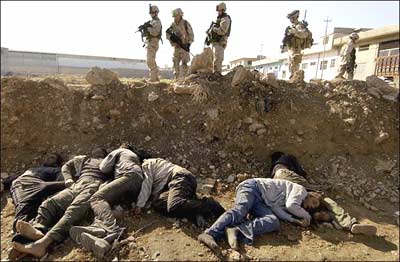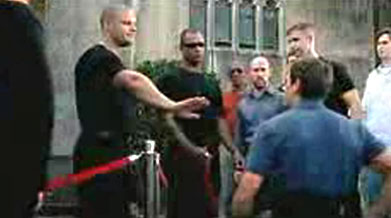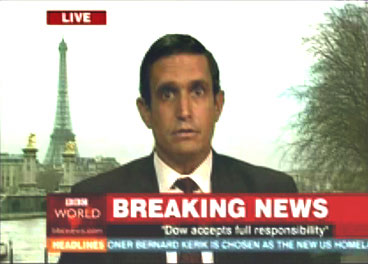Notes
Oh, Death

This shot, from the NYTimes two Friday’s ago, was the second prominent image of murdered Iraqi bodies on the front page that week. Whatever other things the photo editors had in mind, it seemed they were initiating a new level of disclosure for human corpses. At the same time, what I couldn’t understand was why I wasn’t more affected by the image.
Of course, I have some ideas (over and above the general tendency of westerners to deny death).
1. Us vs. Them
The first time I saw this shot was in the newspaper. Before studying it, I didn’t fully appreciate the effect of print quality on the perception of a news image (or the difference between the same shot in print vs. on-line). Because the shot in the paper wasn’t nearly as “sharp” and the color weren’t nearly as distinct, it appeared the corpses were dressed in uniforms. (By the way, the caption described three of the men as wearing Iraqi National Guard uniforms — although it’s still hard to tell from this clearer version.)
At that point, it was no longer about individuals or victims but something more anonymous — good guys versus bad guys. These kinds of deductions can be terribly misleading. In my case, writing off the picture as “just another battle scene” completely overrode the central fact of the photo, which is that the dead men were likely not “bad guys” at all, but military allies and civilian innocents. It also stripped the corpses of any humanity. For example, I made no notice of the one young man in a sympathetically curled position, whose innocent face actual appeals itself to the reader.
2. High vs. Low
There are other things going on which blunt a more personal reaction. The connotations are not just in the image, but in the metaphors one would naturally use to describe them: You have the American’s above (or, on higher ground; or on top) looking down on the Iraqi’s beneath them (or at the bottom; or down below). Of course, there’s also the symbolic association about who’s closer to heaven.
3. Practical Problems
Another problem in relating to the tragedy has to do with the American soldiers. It’s only natural the viewer would look for cues from them as to how to react. An immediate factor here is that the Americans are SO far away! (As distant as they are from the corpses, they are even more distant from the viewer.)
In addition, their reactions are not just impersonal but contradictory. For example, the two Americans on the left look ready for action. Knowing that bombs have been planted on corpses, and that American troops are often unsure whether fallen Iraqis are actually dead, it raises the complicating factor that the victims might still be actors in the scene. Certainly, that indetermination doesn’t do much for empathy.
I also mentioned the impersonality. Of course, one would expect this from soldiers. I would suggest, however, that the American at the far right actually has a disproportionate effect on someone looking at the photo. The inference, at the “wink and nod”-level of communication, is: it’s okay to walk away.
(photo: Jim MacMillan/Associated Press in NYTimes)


Reactions
Comments Powered by Disqus